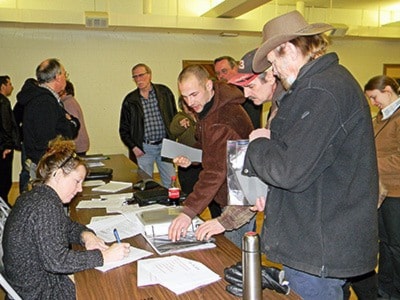In a long and sometimes stormy meeting, officials responsible for the Canim Lake Estates water system met with about two dozen residents worried about contaminants in their water.
Dr. Trevor Corneil, Interior Health Authority (IHA) Medical Health Officer (MHO), identified six compounds and arsenic that contaminated the community’s water supply for a period after modifications to the main reservoir.
Held in the Forest Grove Community Hall on Feb. 7, the meeting was called by the Cariboo Regional District (CRD) to provide residents with information on the state of the water and to answer questions and concerns.
CRD representatives Area H Director Margo Wagner, board chair Al Richmond, and environmental services manager Mitch Minchau, as well as IHA’s Karen Zabaras and representatives of the engineering company, which supervised the contractor who did the work, attended the meeting. Dr. Corneil was connected by speaker-phone.
There are 25 permanent residences using the system, as well as other seasonal properties. As the last of a comprehensive series of measures to improve the safety and reliability of the system, the roof of the main reservoir was repaired and a liner installed to separate the timbers of the roof from the potable water below. The liner installed Dec. 7, 2012 is believed to have infused the water with the strong taste and odour that was first reported to the CRD late on Jan. 8, 2013. By the morning of Jan. 9, a Do Not Use order was issued by the MHO, residents were notified by a door-to-door canvass, and flushing of the system began.
Two labs were hired to do an expedited analysis. Water samples were drawn when the necessary containers were received from the labs, two days after flushing commenced.
Since then, flushing has been completed, the first liner replaced with a different one, and the reservoir cleaned and re-filled.
Dr. Corneil reported that six volatile organic compounds (VOCs) of concern were identified in the first liner samples, as well as arsenic from a fungicide on it. They are Phenol, 2-Butanone, Carbon Disulphide, Methylene methacrylate, Xylenes and Butoxyethoxyethanol.
At the time of the meeting, the level of contamination from the water samples drawn had been determined for four of the VOCs and the arsenic.
Dr. Corneil said the VOC levels were low and comparable to the exposure of someone living in a city close to traffic. He added the arsenic level was well below the set standard in the Canadian Drinking Water Guidelines. He is still awaiting readings on the last two compounds, which are expected this week.
Residents’ concern stemmed from the fact it will never be known how much of the contaminants they were exposed to through the 29 days between the installation of the first liner and the Do Not Use Order.
Dr. Corneil explained it’s believed dilution and the system’s flow rate would have combined to keep the exposure level very low, particularly in view of the short-term presence. However, he could not say there is no risk.
Several residents told him they had experienced effects, such as nausea, headaches and dizziness. He noted that if adults with underlying health complications, such as heart, lung or kidney disease, were concerned, they should see their family physician with a list of the six VOCs and arsenic, and let their physician decide what if any further action is required.
The effects on children were not of as much concern because of their resilient health. Children in the womb, however, are of greater concern, particularly those in the first trimester. Again, the advice was to consult your family physician.
During the weekend, Wagner delivered door-to-door a list of the volatile compounds and arsenic identified by the IHA.
It is hoped the Do Not Use Order will be lifted soon after the last two lab results come in. Another meeting for residents is planned once all results are in and the system is back in full use.
